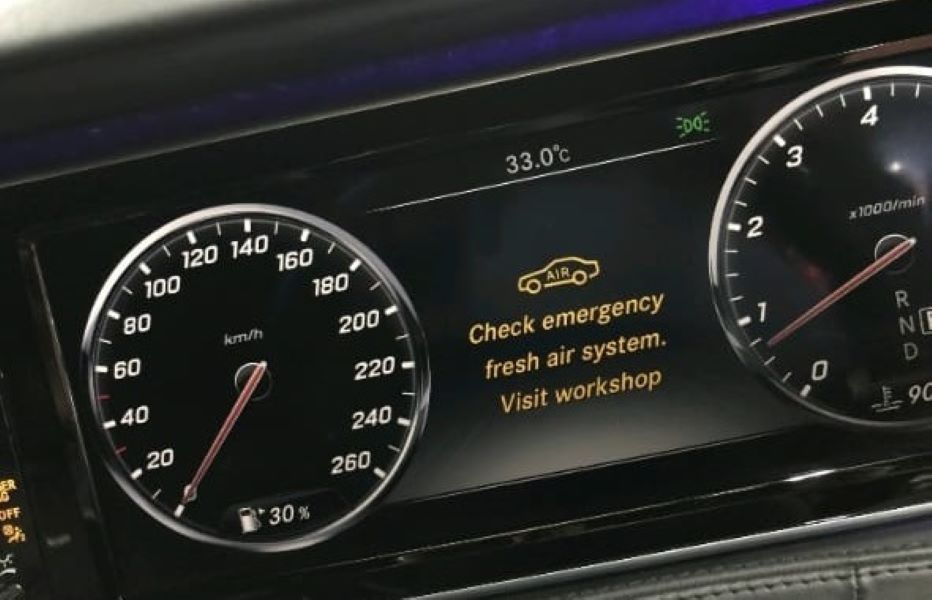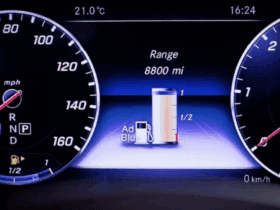Table of Contents
Check Emergency Fresh Air System Warning: Case Study in Mercedes-Benz S Class 222
Check Emergency Fresh Air System is not a warning most drivers expect to see especially in a luxury vehicle like the Mercedes-Benz S Class 222. But when this alert shows up on the instrument cluster, it signals a potential malfunction in one of the car’s critical safety features: the emergency fresh air supply.
This system is designed to protect occupants during fire or smoke emergencies by releasing clean, compressed air into the cabin. When it fails, it’s not just about comfort it’s a matter of safety.
Check Emergency Fresh Air System appeared on the dash of a client’s S-Class, prompting a thorough diagnostic process. Unlike typical fault codes, this issue led us into the rarely serviced fire extinguishing system.
Using STAR diagnosis, visual inspections, wiring checks, and guided tests, we traced the fault to a pressure issue in the fresh air reservoir tank. What followed was a step-by-step investigation that confirmed the root cause and led to a confident repair. Here’s how we solved it.
Customer Complaint
The vehicle, a Mercedes-Benz S Class 222, was brought into the workshop with the warning message “Emergency Fresh Air Function Malfunction” showing on the instrument cluster. This alert can catch even experienced technicians off guard due to the specialized nature of the system involved.

Initial Diagnosis: Fault Code Retrieval
A quick test using STAR diagnosis revealed a fault code related to the fire extinguishing system control unit. The fault indicated that system conditions for the emergency fresh air supply were not met.
Guided Test: Sensor Actuation and Value Check
Following the guided test, I actuated the fresh air reservoir tank pressure sensor and monitored the actual values. The result was clear — the actual value was ‘not OK’, pointing to a pressure issue.

Physical Inspection: Reservoir and Pressure Reading
I performed a visual inspection of the fresh air cylinder. The analog gauge on the tank showed a pressure of 230 bar. However, referencing the wiring diagram and function description, I confirmed that the expected pressure must be above 250 bar for the system to function correctly.
Electrical Testing: Sensor Wire Verification
To investigate further;
- – Connected a test lamp to the two sensor wires: No illumination.
- – Grounded one pin and tested the other: Found ignition-positive voltage.
- – Connected the other pin to direct positive: The actual sensor value changed, and a new fault was stored.
These findings confirmed that the sensor was indeed a pressure switch and that the signal line and power supply were functional.


Final Verification: Resistance Check and Bridging
I measured the resistance across the bulb filaments (used as a substitute load), finding about 4 ohms, which matched expectations. I then bridged the sensor wires, and after running the diagnostic again, no fault codes remained.

Conclusion: Ordering New Parts with Confidence
Based on this thorough diagnosis, I ordered a new fresh air reservoir tank without hesitation. The system warning disappeared after proper installation. This case provided a rare hands-on experience with Mercedes-Benz’s advanced emergency fresh air system, typically only seen in high-end models like the S-Class.


Key Takeaways for Technicians
- – The “Check Emergency Fresh Air System” warning can stem from low pressure in the reservoir tank.
- – Always verify minimum pressure thresholds in this case, 250 bar.
- – Use guided tests and physical verification to confirm whether the fault lies in the pressure sensor, wiring, or the tank itself.
- – Use a test lamp and multimeter to confirm voltage and circuit continuity before replacing components.
- – Bridging the sensor wires as a test can help simulate proper function to confirm diagnosis.
What does “Check Emergency Fresh Air System” mean on a Mercedes?
The “Check Emergency Fresh Air System” warning in a Mercedes typically indicates a malfunction in the vehicle’s emergency air supply system. This system is designed to release clean, compressed air into the cabin during hazardous events such as fire or smoke, protecting occupants.
The warning means the system may not be ready to operate, usually due to low pressure in the fresh air tank or a sensor fault. It’s part of the extended occupant safety features in models like the S-Class and should not be ignored, even though it doesn’t affect regular driving conditions immediately.
Is it safe to drive with the emergency fresh air system warning on?
Yes, your car will continue to drive normally, but it’s not fully safe to ignore the “Check Emergency Fresh Air System” warning. This system is critical in emergencies, especially in situations involving smoke, fire, or gas leaks. If a malfunction is present, it means the cabin air protection feature may not function when needed.
While it’s not an immediate mechanical threat, the system is tied to safety compliance, especially in luxury and armored variants. It’s best to get it diagnosed and repaired to ensure complete protection for you and your passengers.
How do you fix the emergency fresh air system malfunction in a Mercedes S-Class?
To fix the “Check Emergency Fresh Air System” warning in a Mercedes S-Class, the first step is to perform a full diagnostic using a STAR system. Fault codes often point to the fresh air reservoir pressure sensor or control unit. If the sensor returns a “not OK” value, measure the actual pressure on the cylinder (it must be above 250 bar).
If it’s below, the tank likely needs replacement. Also inspect wiring and power supply to the sensor. In some cases, bridging the sensor wires can confirm electrical integrity before ordering parts. Always follow the guided test instructions.
What causes the emergency fresh air system fault in Mercedes vehicles?
The “Check Emergency Fresh Air System” warning is most commonly triggered by low pressure in the compressed air reservoir tank. Mercedes vehicles require a minimum pressure (often above 250 bar) for the system to be deemed operational. Other causes include a faulty pressure sensor, damaged wiring, or an issue in the fire extinguishing system control unit.
In rare cases, software errors or calibration mismatches may also trigger the warning. Since this system is safety-related, any drop in pressure or electrical signal irregularity will immediately raise a fault in the system and illuminate the dashboard warning.
Where is the emergency fresh air reservoir tank located in the S-Class?
In the Mercedes-Benz S-Class (W222), the emergency fresh air reservoir tank is usually located in the engine bay or under the front fender area, depending on the model variant. It’s a high-pressure cylinder designed to store compressed air for emergency release into the cabin during smoke or fire situations.
The tank is connected to the fire extinguishing system and pressure sensor wiring harness. To access it, technicians often need to remove trim panels or covers. Always handle it with care due to its high internal pressure above 250 bar and follow Mercedes-Benz service procedures during diagnostics or replacement.






Leave a Reply